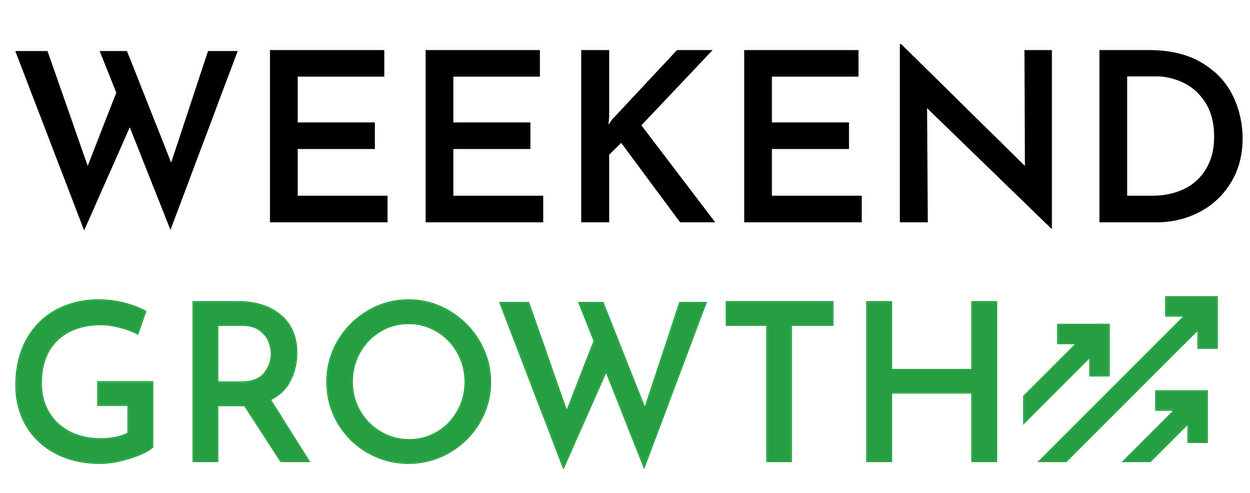For most of the past two decades, I have owned the SERPs for my name “jared bauman”.
Google knew who I was… I had owned a photography studio. An editing company. I had just started a marketing agency. I hosted a podcast. Etc. Then, some dude with the exact same name as me ran for office in the state of Kentucky. Here is what the SERPs looked like in late November:
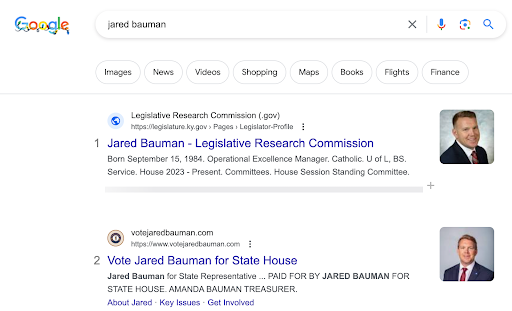
Dude… you’re killing me here! All of this led me down the rabbit hole, and at the bottom was “sameAs” schema.
Quick Navigation
Why You Need Schema in Today’s Online World
Back to that state representative with the same name as me… At the end of the day, my example is pretty trivial in the real world. Anyone searching for “me” will know to move past the government official until they see “me.”
But that’s not the point. Google can’t be expected to do that. They’re a bot. How do I know Google knows me from state representative dude?
My active Twitter profile? My expertise as the host of the popular Niche Pursuits podcast? My previous companies, my authorship on major SEO publications → who’s getting the “credit” for that? Me or Kentucky dude?
These questions then create a chain reaction…If I can’t be sure that “me” is getting credit for all this, how about all of my entities?
201 Creative, my marketing agency. “I” own and manage it. Does Google know that? Or do they think a US government official runs an SEO agency? If so, they probably don’t think he has much experience or expertise in SEO…
Let’s say you own a website. And you are active in the niche. You’ve been published. You have expert authors. Are you sure you’re getting proper “credit” for all this? Google’s E-E-A-T… the HCU… it’s never been more important to ensure Google knows these things!
Enter “sameAs” schema.
Did you miss my video on how to see whether Google trusts your site?
What Is “sameAs” Schema?
Alright, let’s get into the nitty-gritty of what “sameAs” schema really is.
Think of “sameAs” schema as your digital resume. It’s a specific type of structured data that you add to your website’s HTML. This code acts like a series of digital signposts, pointing search engines to all the different places you exist online.
It’s like saying, “Hey Google, this is me on Twitter, Facebook, LinkedIn, and these are my other websites.”
Connecting the Dots
The beauty of “sameAs” schema is in its ability to connect the dots between your website and your various online profiles. Whether it’s your social media accounts, business directories, or other relevant pages, “sameAs” schema links them all to your site.
This linkage is crucial because it helps search engines understand that all these profiles represent the same entity – you or your brand.
Why It’s a Big Deal
Unless you’re a prominent figure head, pop star, pro athlete, etc, the big Google might not know much about you. And in a world where E-E-A-T exists (to some degree), that can be a big deal.
Further, unless you have a personal Wikipedia page, chances are Google could stand to learn more about who you are, what you are an expert in, where you’ve been featured, etc.
The same is true for your website. Want to stand out and not look like a “niche site” online? First, you need your website featured in prominent places (this isn’t a blog post on how to do that). Then, using “sameAs” schema can help Google connect the dots.
Beyond Just Links
While “sameAs” schema involves linking to your profiles, it’s more than just hyperlinking. It’s about creating a network of verified, authoritative connections that search engines can trust.
This trust translates into better understanding and representation of your brand in search results, enhancing your visibility and potentially improving your rankings.
Where to Add It
Ok, so I’m still diving deeper into this, because I think there is room for several differing approaches here. For the sake of clarity, I’m going to focus on using “sameAs” schema to substantiate company and individual expertise.
So, I want to add “sameAs” schema to the entire website for my company social accounts, prominent profiles, and any other important trust validating sources.
I’ll also be adding detailed “sameAs” schema to author pages for those particular people and their similar things.
Note: I’ve seen a little debate about whether sameAs schema is still relevant after Google expanded ProfilePage schema in November 2023. I’m still adding things like social profiles to sameAs schema, but I’ll admit that I’m paying attention to these details going forward!
Your website might be missing “sameAs” schema, but it might also be missing a lot more. I see hundreds of websites every month at my agency – our popular Website Review and Consulting services might be a big help to you!
How to Implement “sameAs” Schema
Now, let’s roll up our sleeves and dive into the practical part – implementing “sameAs” schema on your website. Don’t worry, it’s not as daunting as it sounds.
Step 1: Choosing Your Profiles Wisely
When it comes to “sameAs”, think quality over quantity. Link to profiles that genuinely represent your brand and contribute to its authority. This isn’t really the time to link to that Twitter account you haven’t used since 2012. Focus on active, relevant profiles that enhance your brand’s credibility. Here is a punch list to consider:
- YouTube
You’ll see in my examples below that you can also add prominent places that you are featured, or other places where you have noteworthy work published.
Step 2: Understanding JSON-LD
First things first, “sameAs” schema is typically implemented using JSON-LD (JavaScript Object Notation for Linked Data). If you use a plugin, it will likely still use JSON to implement.
JSON-LD is a script-based method that makes it easy to add structured data to your website.
Step 3: Crafting Your JSON-LD Script
Here’s where you create the actual code. Don’t panic; you don’t need to be a coding wizard. There are plenty of JSON-LD generators online, or you can use the template I’ll provide. The key is to replace the placeholders with your actual profile URLs. Here’s a basic template:
<script type=”application/ld+json”>
{
“@context”: “http://schema.org”,
“@type”: “Organization”,
“name”: “Your Brand Name”,
“url”: “https://www.yourwebsite.com”,
“sameAs”: [
“https://www.facebook.com/yourbrand”,
“https://www.twitter.com/yourbrand”,
“https://www.linkedin.com/company/yourbrand”,
// Add other social profiles or relevant URLs here
]
}
</script>
Step 4: Inserting the Script into Your Website
Once your script is ready, it’s time to add it to your website. The best place to insert this JSON-LD script is within the <head> section of your website’s HTML.
This can be done through your website’s CMS (like WordPress) or directly editing the HTML if you’re comfortable with that. If you’re using a CMS, there are often plugins or settings where you can add custom scripts like this.
Step 5: Testing Your Implementation
After adding the script, it’s crucial to ensure everything is working correctly. Google’s Structured Data Testing Tool is your friend here. Specifically, I use the Rich Results test.
Plug in your URL, and it’ll tell you if there are any issues with your schema implementation. This step is like proofreading your work – always a good practice. More on this below – I show tons of screenshots of this test in action.
I’ve dissected HCU factors people are seeing, and put them into one, easy-to-read spreadsheet. 124 questions to ask yourself about your website – download here!
Real World Examples of sameAs Schema
So, let’s start with looking at examples of companies and their “sameAs” schema. Remember, the train of thought I’m running with is that you want to add “sameAs” schema to the entire website for your company social accounts, prominent profiles, and any other important trust validating sources.
And then let’s look at their individual Author schema.
Very Well Fit
Let’s start with a Dotdash Meredith company: Very Well Fit. As it turns out, they have their “sameAs” schema dialed in.
Company “sameAs” Schema
We see that they have “sameAs” schema set up for all of their social profiles.
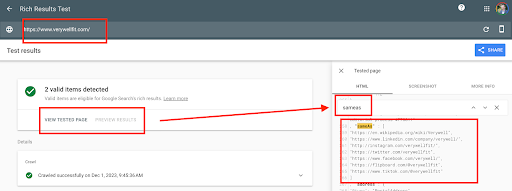
“sameAs” : [
“https://en.wikipedia.org/wiki/Verywell”,
“https://www.linkedin.com/company/verywell/”,
“http://instagram.com/verywellfit/”,
“https://twitter.com/verywellfit”,
“https://www.facebook.com/verywell/”,
“https://flipboard.com/@verywellfit”,
“https://www.tiktok.com/@verywellfit”
]
We see additional schema for their parent company Dotdash Meredith as well!

So, they are doing a tremendous job of telling Google all about the parent company (Dotdash Meredith) AND the website brand (VeryWellFit).
Author “sameAs” Schema
I pulled the author page of a random author I found on the site: https://www.verywellfit.com/april-benshosan-7561924
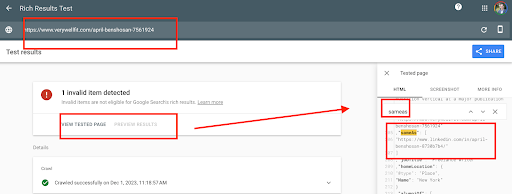
We can see that they are linking to April’s LinkedIn page in the “sameAs” schema.
So there it is in basic form. April is an author for VeryWellFit, and she also is a real person who has a LinkedIn account as well. VeryWellFit is a website entity in and of itself, owned by parent company Dotdash Meredith. All laid out for Google to see and understand.
Brides
Sticking with Dotdash Meredith, let’s look at Brides.com. A recent consulting call brought them up and it turns out that they’re a good example.
Company “sameAs” Schema
Just like in the previous example, we see a very well organized “sameAs” schema structure set up for both the parent company (Dotdash Meredith) and the website (Brides).
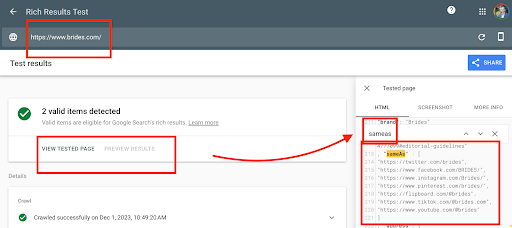
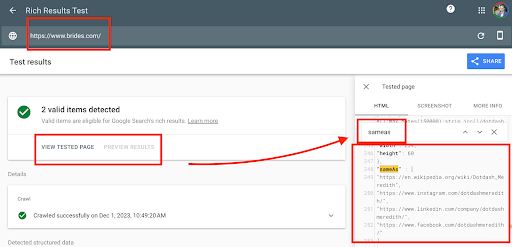
Author “sameAs” Schema
Once again, Brides nails their Author page “sameAs” schema. Let’s look at a random author I pulled: Blair Donovan.
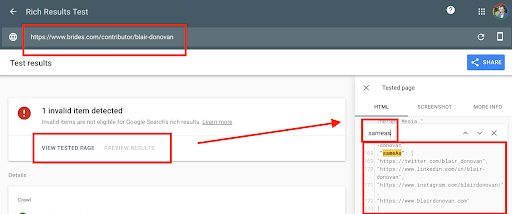
“sameAs”: [
“https://twitter.com/blair_donovan”,
“https://www.linkedin.com/in/blair-donovan”,
“https://www.instagram.com/blairdonovan/”,
“https://www.blairdonovan.com”
]
They’ve got her Twitter, Instagram, and LinkedIn social profiles. And… her personal author website! Her website is nothing fancy, but it sure appears to be real!

Clicking on the “Writing” link, look at all the publications she writes for! Now that’s some E-E-A-T…
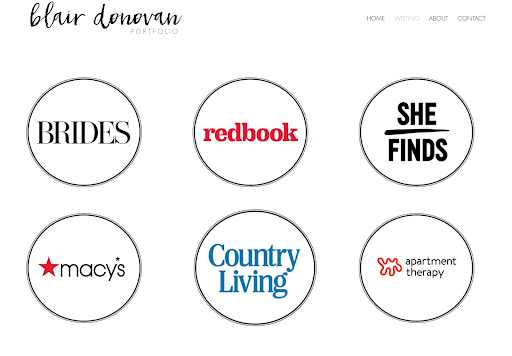
And, an About page, with links to? All of those very same social profiles!
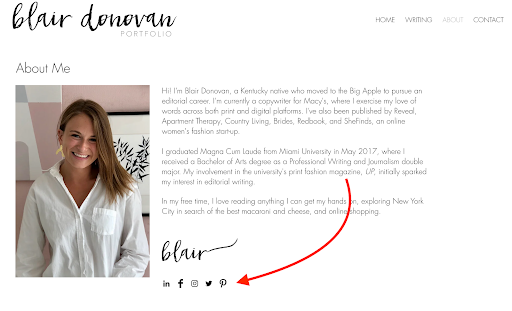
Oh, and if you’re wondering, click through on some of the social profiles. She looks pretty legit.
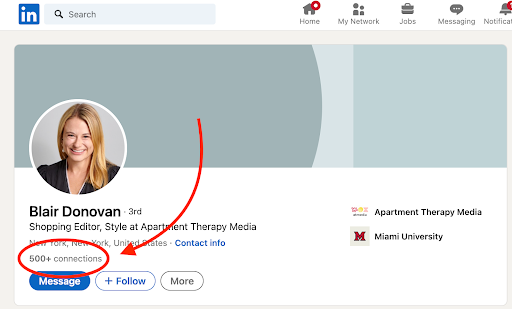
We’re starting to see a masterclass in “connecting the dots” for Google. Can they connect many of these dates on their own? Yes, for sure. But why not connect the dots for them?
“sameAs” schema for the win.
Authority Hacker
When it comes to nerdy technical stuff for websites and SEO, I always like to see what Gael Breton of Authority Hacker is doing. I recently interviewed him on the podcast, and so he came up as a great example to check out what his company is doing.
Company “sameAs” Schema
Sure enough, Authority Hacker has “sameAs” schema set up. They are showing Google all of the other properties that they have.
https://www.authorityhacker.com/
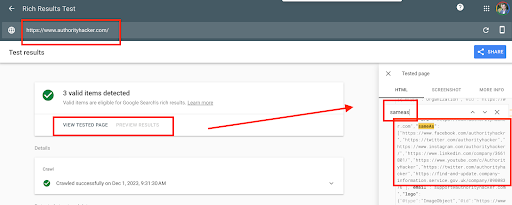
“sameAs”:[
“https://www.facebook.com/authorityhackr“,
“https://twitter.com/authorityhacker“,
“https://www.instagram.com/authorityhacker/“,
“https://www.linkedin.com/company/3661801/“,
“https://www.youtube.com/c/AuthorityHacker“,
“https://twitter.com/authorityhacker“,
“https://find-and-update.company-information.service.gov.uk/company/09008376“
]
See how they’re linking to more than just social profiles? They have a link to a Company Information Service… helping to legitimize their business entity.
Author “sameAs” Schema
Looking an Gael’s author page, he includes several of his social profiles along with other identifying profiles that are trusted by Google:
sameAs”:[
“https://www.authorityhacker.com“,
“https://www.facebook.com/gael.breton/“,
“https://twitter.com/https://twitter.com/GaelBreton“,
“https://www.crunchbase.com/person/gael-breton“,
“https://mangools.com/blog/guest-author/gael-breton/“,
“https://medium.com/@galbreton]
201 Creative
Alright, well, it’s time to turn the mirror back on myself. And, you can see that this can often be a work in progress. You see, my agency 201 Creative doesn’t really have any active social profiles. I’ve always just been active on my personal accounts.
We do have a LinkedIn account, but it’s nothing more than a site. Perhaps I need to change that in 2024. But, for now, I use what I have!
sameAs”:[
“https://www.facebook.com/201creative“,
“https://www.linkedin.com/company/201-creative-llc/“,
“https://www.facebook.com/201creative“]
But, speaking of my personal accounts, I DID add those my author page on 201 Creative.
https://201creative.com/author/jared/
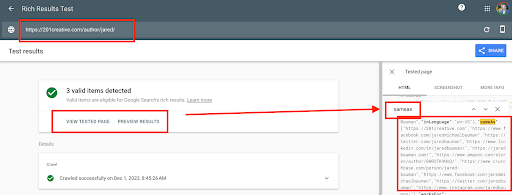
“sameAs”:[
“https://201creative.com”,
“https://www.facebook.com/jaredmichaelbauman”,
“https://twitter.com/jaredbauman”,
“https://jaredbauman.com/”,
“https://linkedin.com/in/jaredbauman/”,
“https://www.instagram.com/jaredbauman/”,
“https://www.amazon.com/stores/author/B00DTK9NUQ/”,
“https://www.crunchbase.com/person/jared-bauman”
]
You can see that, in addition to my social profiles, I also link to my published book on Amazon and my Crunchbase profile. Amazon and Crunchbase are likely contributors to Google’s Knowledge Graph 🙂 More on that in some future article.
By the way, it’s the same for this brand, Weekend Growth:
https://weekendgrowth.com/author/jared/
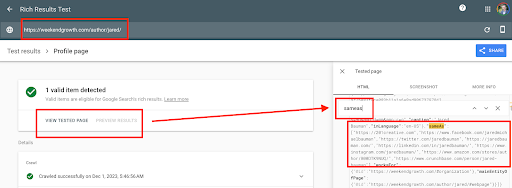
Wrapping It Up
To sum it up, “sameAs” schema is a strategic tool that can be used to connect your various entities in a way that Google can clearly see and understand. By linking your content to your broader online presence, you’re not only enhancing your visibility but also establishing a stronger, more cohesive brand identity.
In a world where small publishers are up against Google’s preference for larger brands, this is one of many ways we can help establish our legitimacy.
Next week… I’ll show you how just following these “sameas” schema practices helped me make a HUGE dent in owning the SERPs for my name! And it did not take long!
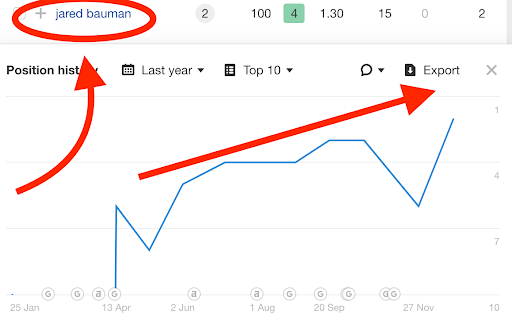
Remember – if you need help with your schema, my agency can help out! Just reach out here and let us know what you need.
Addendum (Read This Before Messaging Me)
- Don’t take this article’s length to think that I’m implying Schema is the end all, be all. No, doing this alone will more than likely NOT help you recover from the HCU. Schema helps connect dots for Google, but it can’t make up for not having any of these entities on the web.
- Yes, I know sites like VeryWellFit and Brides did not “win” in the HCU. Again, this is not a “recovery” strategy, nor is it a “how to win at updates” strategy. Ranking involves a whole host of things.
